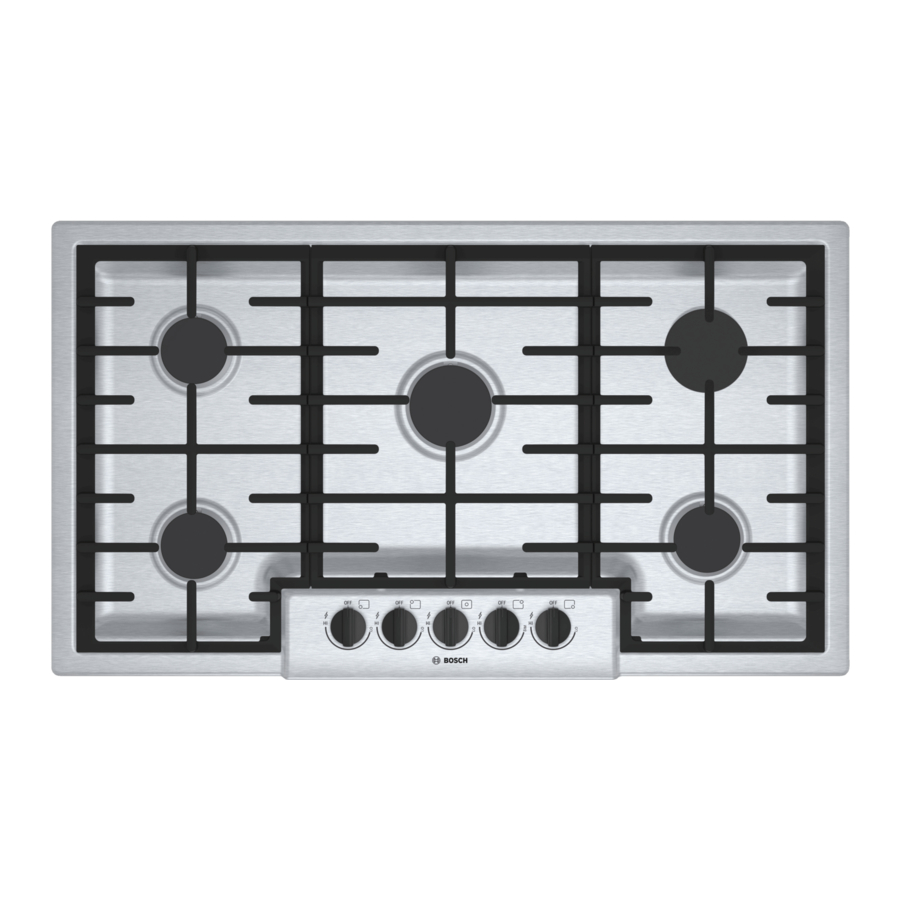
Bosch NGM5056UC; NGM5656UC; NGM8056UC; NGM8656UC - Gas Cooktop Manual
- Use and care manual (60 pages) ,
- Installation manual (40 pages) ,
- Installation manual (40 pages)
Advertisement
- 1 Getting Started
- 2 Operation
- 3 Cleaning and Maintenance
- 4 Service
- 5 Safety Definitions
- 6 IMPORTANT SAFETY INSTRUCTIONS
- 7 Documents / Resources

Getting Started
Before Using the Appliance for the First Time
- Remove all packing materials and literature from the cooktop surface.
- Wipe with a clean, damp sponge and dry.
- There may be a slight odor during the first several uses. This is normal and will disappear.
- Optimum cooking results depend on the proper cookware being selected and used. See "Choosing Cookware - Cookware Recommendations".
- Read all safety precautions and Use and Care Manual information prior to operating.
OptiSim® Feature
OptiSim® has been designed to work with the small burner located in the rear position of the cooktop and is used to provide optimal simmering for delicate sauces while minimizing the risk of scorching.
The small auxiliary burner cap can be replaced with the OptiSim® burner cap. Refer to the Installation Guide included with the cooktop for complete instructions on how to correctly install the OptiSim® burner.
Parts and Accessories
NGM5056UC
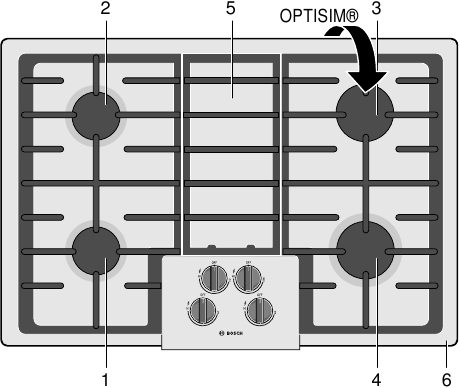
- Left front burner (10,000 BTU/ 2.93 kW)
- Left rear burner (10,000 BTU/ 2.93 kW)
- Right rear burner (5,500 BTU/ 1.61 kW) *OPTISIM® feature
- Right front burner (16,000 BTU/ 4.69 kW)
- Grate bridge
- Serial Number/Data Plate location (right front underneath)
*See section OptiSim® Burner Cap Placement and OptiSim® Burner Cap Installation for further information.
NGM8056UC
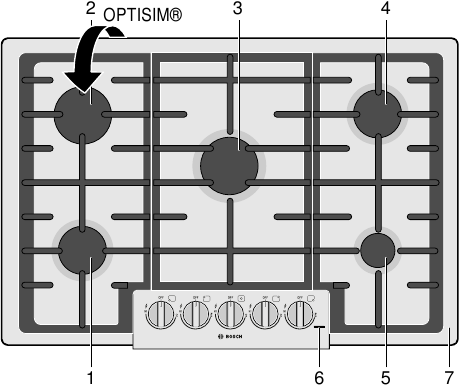
- Left front burner (10,000 BTU/ 2.93 kW)
- Left rear burner (5,500 BTU/ 1.61 kW) *OPTISIM® feature
- Center burner (19,000 BTU/ 5.57kW)
- Right rear burner (10,000 BTU/ 2.93kW)
- Right front burner (5,500 BTU/ 1.61kW)
- Burner "On" indicator light
- Serial Number/Data Plate location (right front underneath)
*See section OptiSim® Burner Cap Placement and OptiSim® Burner Cap Installation for further information.
NGM8046UC
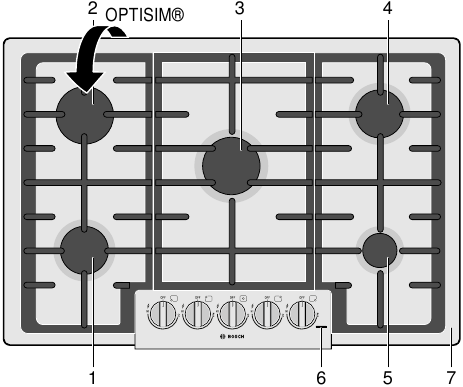
- Left front burner (9,300 BTU/ 2.72 kW)
- Left rear burner (5,500 BTU/ 1.61 kW) *OPTISIM® feature
- Center burner (19,000 BTU/ 5.57kW)
- Right rear burner (9,300 BTU/ 2.72kW)
- Right front burner (5,500 BTU/ 1.61kW)
- Burner "On" indicator light
- Serial Number/Data Plate location (right front underneath)
*See section OptiSim® Burner Cap Placement and OptiSim® Burner Cap Installation for further information.
NGMP056UC
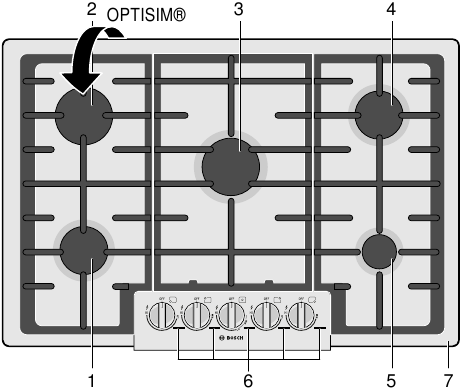
- Left front burner (10,000 BTU/ 2.93 kW)
- Left rear burner (5,500 BTU/ 1.61 kW) *OPTISIM® feature
- Center burner (20,000 BTU/ 5.86 kW)
- Right rear burner (10,000 BTU/ 2.93 kW)
- Right front burner (5,500 BTU/ 1.61 kW)
- Burner "On" indicator light
- Serial Number/Data Plate location (right front underneath)
*See section OptiSim® Burner Cap Placement and OptiSim® Burner Cap Installation for further information.
NGM5656UC, NGM8656UC
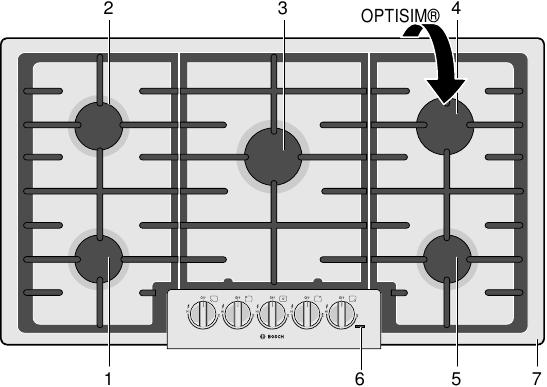
- Left front burner (10,000 BTU/ 2.93 kW-NGM5656UC)
Left front burner (12,000 BTU/ 3.52 kW-NGM8656UC) - Left rear burner (10,000 BTU/ 2.93 kW)
- Center burner (16,000 BTU/ 4.69 kW- NGM5656UC)
Center burner (19,000 BTU/ 5.57 kW- NGM8656UC) - Right rear burner (5,500 BTU/ 1.61 kW) *OPTISIM® feature
- Right front burner (10,000 BTU/ 2.93 kW-NGM5656UC)
Right front burner (12,000 BTU/ 3.52 kW-NGM8656UC) - Burner "On" indicator light (500 Series does not have a light)
- Serial Number/Data Plate location (right front underneath)
*See section OptiSim® Burner Cap Placement and OptiSim® Burner Cap Installation for further information.
NGM8646UC
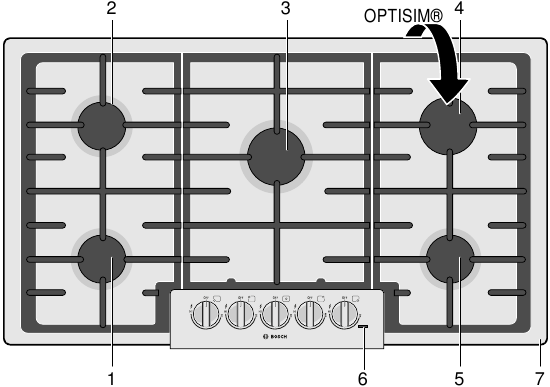
- Left front burner (9,300 BTU/ 2.72 kW)
- Left rear burner (9,300 BTU/ 2.72 kW)
- Center burner (19,000 BTU/ 5.57 kW)
- Right rear burner (5,500 BTU/ 1.61 kW) *OPTISIM® feature
- Right front burner (9,300 BTU/ 2.72 kW)
- Burner "On" indicator light
- Serial Number/Data Plate location (right front underneath)
*See section OptiSim® Burner Cap Placement and OptiSim® Burner Cap Installation for further information.
NGMP656UC
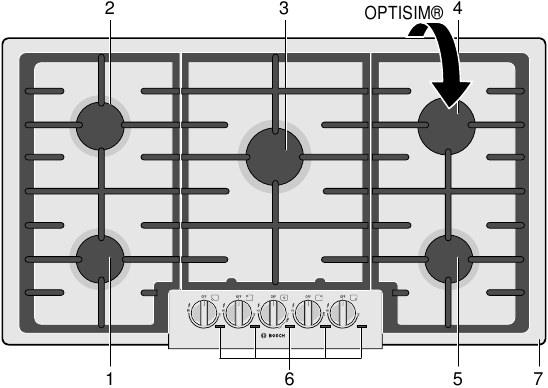
- Left front burner (12,000 BTU/ 3.52 kW)
- Left rear burner (10,000 BTU/ 2.93 kW)
- Center burner (20,000 BTU/ 5.86 kW)
- Right rear burner (5,500 BTU/ 1.61 kW) *OPTISIM® feature
- Right front burner (12,000 BTU/ 3.52 kW)
- Burner "On" indicator lights
- Serial Number/Data Plate location (right front underneath)
*See section OptiSim® Burner Cap Placement and OptiSim® Burner Cap Installation for further information.
Sealed burners
Your new cooktop has sealed gas burners. There are no burner parts under the cooktop to clean, disassemble or adjust. Your cooktop has three different burner sizes: small, medium, and large.
Burner Cap and Burner Base Placement
To prevent flare-ups, do not use the cooktop without all burner caps and all burner grates properly positioned.
To prevent burns, do not touch burner caps or grates while hot. Turn the cooktop off and allow the entire cooktop to cool.
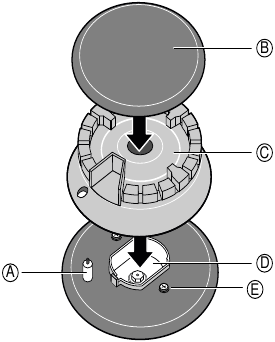
- Igniter
- Burner Cap
- Burner Base
- Jet Holder
- Panhead Screw
The burner caps must be properly placed for the cooktop to function properly. If the burner cap is not properly placed, one or more of the following problems may occur:
- Burner flames are too high.
- Burner flames extend too far on sides.
- Stainless steel discolors.
- Burners do not ignite.
- Burner flames light unevenly.
- Burner emits gas odor.
Correct Burner Cap Placement
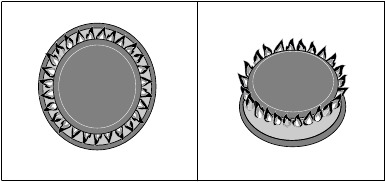
Incorrect Burner Cap Placement
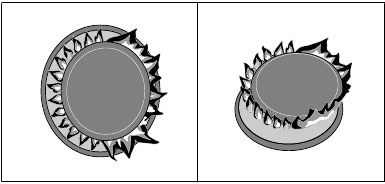
Burner Base and Burner Cap Placement
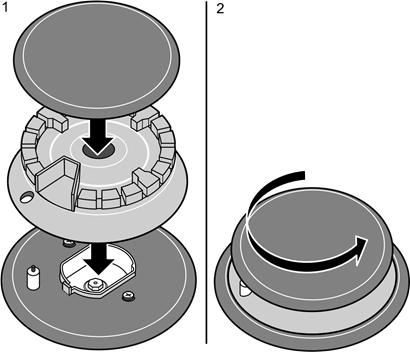
- After electrical connection is complete, place each burner base on the corresponding location on the cooktop.
- Pay special attention to avoid damaging the igniter during installation of the base.
- The small hole or cutout near the edge should also line up with the igniter.
- Once each burner base is located and resting evenly, place each burner cap on its correct burner base.
- Place burner cap gently on top of base so that the prongs of the burner base fit snugly into the groove of the burner cap.
- Make sure the cap is centered on the burner base and lies flat and that there is no gap between the burner base and the burner cap.
![Bosch - NGM5056UC - Burner Cap Placement Burner Cap Placement]()
- Gently try to move the burner cap from side to side to check for proper placement. If placement is correct, the cap will click from side to side as the prongs hit the grooved ridge on the underside of the cap.
- If the maintop is removed by a certified installer (for example to check electrical or piping connection) the panhead screws that were removed must be reinstalled to ensure proper functionality of burners.
Correct Placement for Burner Base and Burner Cap
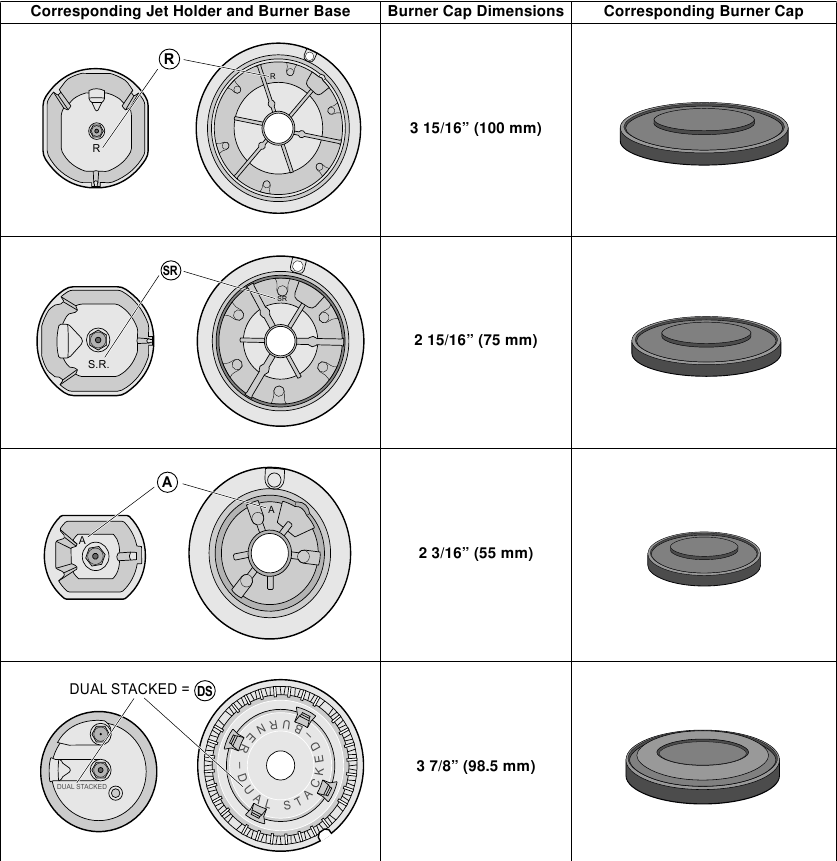
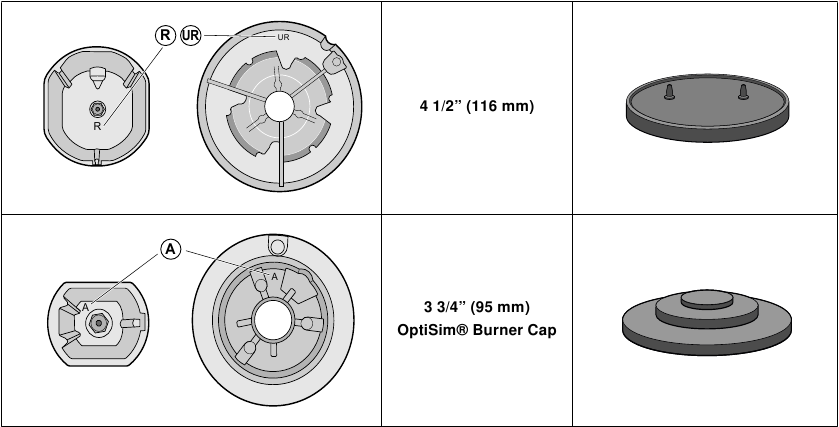
- The jet holder and the burner base have corresponding letter demarcations to ensure proper placement of the burner base.
- The corresponding letters can be found on the inside bottom of the jet holder and on the bottom of the burner base.
Notes
- The cooktop comes with an extra burner cap.
- The A/A burner cap is for an auxilary burner. It can be replaced with the OptiSim® burner cap. See instructions under OptiSim® Burner Cap Placement for proper location and correct installation.
The OptiSim® has been designed to work with the small burner located in the rear position of the cooktop and is used to provide optimal simmering for delicate sauces while minimizing the risk of scorching.
OptiSim® Burner Cap Placement
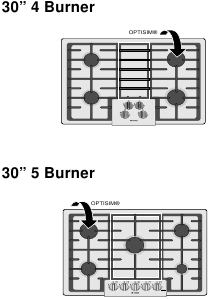
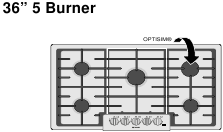
OptiSim® Burner Cap Installation
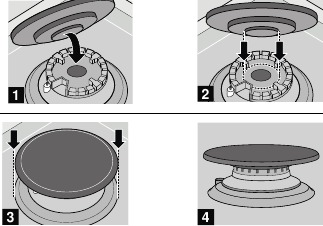
When properly installed the cap will extend beyond the burner base and raised surface.
Burner "ON" light
An "On" light is located on the cooktop. When illuminated, it indicates at least one burner is in use (no light on the 500 Series).
Install Burner Grates
Properly position and install each burner grate as shown in the illustration below.
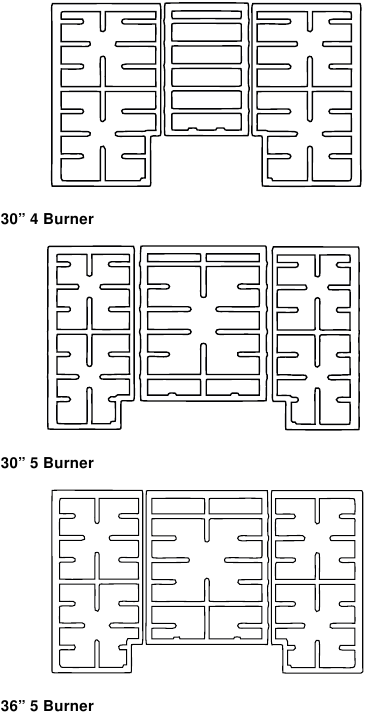
To prevent flare-ups, properly support pots and avoid spills, all grates must be properly positioned on the cooktop whenever the cooktop is in use. Each of the four feet must be placed into the corresponding dimples in the cooktop. Do not use a grate if the rubber feet are missing or damaged.
For replacement of rubber feet: Call Customer Support at 1-800-944-2904.
Control Knobs
The cooktop has one control knob for each burner. Push down and turn to the left to light and set the desired heat setting.
Failure to operate knobs properly may result in personal injury and damage to the appliance.
The cooktop has standard burner controls and rubber grommets.
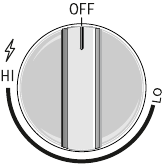
The standard burner controls have an infinite number of heat settings.
To operate: Select the appropriate control knob, push down and turn counterclockwise to the desired flame size. Turn off by turning the control knob clockwise to OFF.
Control Knob Removal
To remove knob: With control knob in the OFF position, gently lift knob up and off.
To avoid possible electric shock, do not reach through control opening into rough-in box.
Do not use the appliance without the knobs in place.
To replace knob: Replace control knob by placing indicator line at the OFF position. Press down firmly.
Operation
About the Appliance
Use the cooktop for surface cooking applications such as boiling, frying, simmering, steaming and sautéing.
The burning of gas cooking fuel can create small amounts of carbon monoxide, benzene, formaldehyde and soot. To minimize exposure to these substances, the burners should be adjusted by a certified installer or authorized servicer to ensure proper combustion. Ensure proper ventilation with an open window or use a ventilation fan or hood when cooking with Gas. Always operate the unit according to the instructions in this manual.
Normal Operation - Electronic Ignition/Reignition
The cooktop uses electronic igniters to light the burners. There is no pilot light. Each burner has its own igniter. If a burner flame blows out during use, the burner will automatically reignite.
To avoid possible injury or damage to the appliance, ensure grates are installed exactly per installation instructions and not backwards or upside down.
The igniter should be clean and dry for proper operation.
- Avoid getting water or food on the igniter.
- If the igniter is wet or soiled, it may spark without igniting the burner, or even spark continuously when a flame is present.
Note: If the burner does not light within 4 seconds, turn the burner off. Check to see that the burner cap is positioned correctly on the burner base and the igniter is clean and dry. If a burner still fails to ignite, see "Before Calling for Service".
When a flame is present and a Low setting is used, the igniter may occasionally spark. This is normal.
To avoid possible injury or damage to the appliance, ensure grates are installed exactly per installation instructions and not backwards or upside down.
Typical Flame Characteristics
The burner flame should be blue in color and stable with no yellow tips, excessive noise or fluttering. It should burn completely around the burner cap.
Checking Flame Characteristics:
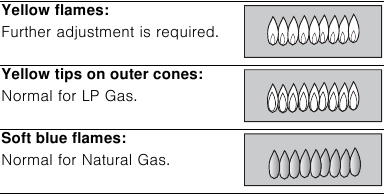
- If the flame is completely or mostly yellow, verify that the regulator is set for the correct fuel. After adjustment, retest.
- Some yellow streaking is normal during the initial startup. Allow unit to operate 4 to 5 minutes and reevaluate before making adjustments.
- Foreign particles in the gas line may cause an orange flame during initial use. This should disappear with use. Check burner to make sure port holes are not obstructed. If the ports are clogged. → "Before Calling for Service"
Note: An audible "pop" may be heard when the burner is turned off manually. The "popping" may be louder with LP gas than with natural gas. This is normal.
Getting the most out of your appliance
Cooking suggestions for best results
- Boil water in covered pot on High using largest burner for best results. If water boils over, turn to a lower setting.
- When melting chocolate or butter, use smallest burner with OPTISIM® feature for best results.
- When simmering, bring food to a boil first. Stir well to be sure all the food is boiling, then cover and reduce the flame to the desired setting to simmer.
- There should be steam and slight quivering of the liquid's surface while simmering.
- Use a lid to keep a more constant cooking temperature and heat food faster.
- Check the food occasionally to see if the control knob should be turned to a lower or higher setting.
- It is normal to stir food occasionally.
- Center the pan over the burner before turning the burner on.
- Use proper cookware. → "Proper Cookware"
- Refer to the settings recommendations in the following chart for suggested settings.
Settings recommendations
| Uses | Heat setting |
| Boiling (i.e. water, stock, etc.) | High |
| Pan frying, sautéing, browning meat, deep frying | Medium High |
| Shallow frying, eggs, pancakes, bacon | Medium |
| Steaming, braising | Medium Low |
| Melting chocolate, melting butter, simmering sauces, soups and stews (i.e. tomato sauce, Alfredo sauce, beef stew, etc.) Note: When melting chocolate or butter, use smallest burner with OPTISIM® feature for best results. | Low |
Proper Cookware
- Aluminum or copper bottomed pans conduct heat evenly.
- Steel pans, if not combined with other metals, may cook unevenly.
- Cast-iron cookware absorbs heat slowly and cooks more evenly at low-to-medium settings.
- Flat heavy bottom pans provide even heat and stability.
- DO NOT USE pans that are thin, warped, dented or ridged as they heat unevenly.
Choosing Suitable Cookware
Cookware Recommendations
Pan Bottom Diameter
PREVENTING BURNS FROM HOT KNOBS
Ensure the cookware does not exceed the size of the grates. Cookware that is larger than the grates may cause the flames to get too close to the knobs creating a burn hazard when touched.
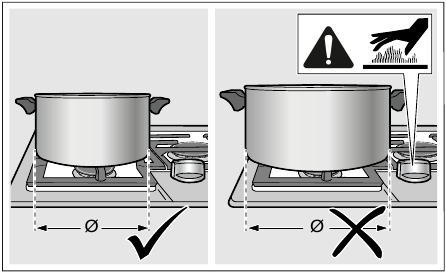
- The flame should be the same size as the bottom of the pan or smaller.
- Do not use small pans with high flame settings as the flames can spread up the sides of the pan.
- Oversized pans that span two burners should not exceed the size of the grates and should be placed front to back, not side to side.
Use Balanced Pans

- Balance is important for stability and even cooking.
- Pans must sit level on the cooktop grate without rocking or wobbling.
- Center pan over burner.
Proper Fitting Lid

- A well-fitting lid helps shorten the cooking time.
- For best cooking results, always use a lid when boiling water.
Specialty cookware
- Pans that span 2 burners, i.e. griddles, roasters and fish poachers, may be used when placed front to back and should not exceed the size of the grates. Adjust flame equally to cook evenly.
- Use a Wok with a flat bottom.
- Canners and pressure cookers must meet the same requirements as described above. After bringing contents to a boil, use lowest heat setting possible to maintain a boil or pressure (for pressure canners/cookers).
Cleaning and Maintenance
Cleaning
The entire cooktop can be safely cleaned by wiping with a soapy sponge, then rinsing and drying. If stubborn soil remains, follow the recommended cleaning methods below.
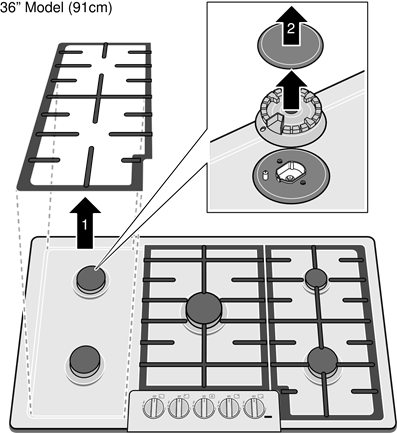
Cleaning recommendations:
- Always use the mildest cleaner that will do the job. Use clean, soft cloths, sponges or paper towels.
- Rub stainless steel finishes in the direction of the grain. Wipe area dry to avoid water marks.
- Before cleaning, be certain the burners are turned off and the grates and burners are cool.
- Do not clean removable cooktop parts in any self cleaning oven or dishwasher.
- After cleaning, place all parts in their proper positions before using cooktop.
- For proper burner performance, keep igniters clean and dry.
- Keep the igniter ports clean for proper lighting performance of the burners. It is necessary to clean these when there is a boilover or when the burner does not light even though the electronic igniters click.
- Do not use flammable cleansers such as lighter fluid.
All igniters spark when any single burner is turned on. Do not touch any of the burners when the cooktop is in use.
Cleaning Guidelines
The cleaners recommended below indicate a type and do not constitute an endorsement of a particular brand. Use all products according to package directions.
| Cooktop part / material | Suggested cleaners | Important reminders |
| Burner base / aluminum alloy |
|
|
| Burner cap / porcelain enamel |
|
|
| Control knobs and grommets |
|
|
| Exterior finish / stainless steel |
|
|
| Grates and grate bridge / porcelain enamel on cast iron |
|
|
| Igniters / ceramic |
|
|
Maintenance
The appliance requires only regular cleaning for proper operation. No other maintenance is required.
For detailed instructions see → "Cleaning and Maintenance"
Service
Before Calling for Service
Before calling Customer Service, consider the suggestions and instructions below:
Repairs should only be done by an authorized servicer.
Improper repair of your appliance may result in risk of severe physical injury or death.
| Problem | Suggestion |
| Burner(s) do not light / igniters do not spark |
|
| Burner flame goes out unexpectedly | Make sure that there is not draft in the room. |
| Igniters spark even though knobs are in the off position | When the electrical power connection has been activated at the first power up or reconnected after an outage, the igniters may spark once or twice, even though all burner knobs are in the "OFF" position. |
| Cooking results are not what was expected |
|
Product Rating Label
The rating label shows the model number and the FD number (production number/product's unique identifier) of your cooktop. It is located on the underside of the cooktop.
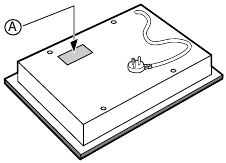
Rating Label Location
- Rating Label
Model number and FD Number
The model number and the FD number of your appliance are found on the rating label. Make a note of these numbers in the space below to save time in the event your appliance requires service.
| Model # | FD # |
| Bosch Customer Support | 800-944-2904 |
Keep your invoice or escrow papers for warranty validation if service is needed.
Safety Definitions
This indicates that death or serious injuries may occur as a result of non-observance of this warning.
This indicates that minor or moderate injuries may occur as a result of non-observance of this warning.
NOTICE: This indicates that damage to the appliance or property may occur as a result of non-compliance with this advisory.
Note: This alerts you to important information and/or tips.
IMPORTANT SAFETY INSTRUCTIONS

 If the information in these instructions is not followed exactly, a fire or explosion may result causing property damage, personal injury or death.
|
SAVE THESE INSTRUCTIONS FOR THE LOCAL ELECTRICAL INSPECTOR'S USE.
INSTALLER: LEAVE THESE INSTRUCTIONS WITH THE UNIT FOR THE OWNER.
OWNER: PLEASE RETAIN THESE INSTRUCTIONS FOR FUTURE REFERENCE.
When properly cared for, your new appliance has been designed to be safe and reliable. Read all instructions carefully before use. These precautions will reduce the risk of burns, electric shock, fire and injury to persons. When using kitchen appliances, basic safety precautions must be followed including those in the following pages.
Fire Safety
Save these instructions.
Set the burner control so that the flame does not extend beyond the bottom of the pan.
Do not allow aluminum foil, plastic, paper or cloth to come in contact with a hot surface element, burner or grate. Do not allow pans to boil dry.
If the cooktop is near a window, forced air vent or fan, be certain that flammable materials such as window coverings do not blow over or near the burners or elements. They could catch on fire.
Always have a working smoke detector near the kitchen.
Never leave the cooktop unattended when in use. Boilovers cause smoking and greasy spillovers may ignite.
TO REDUCE THE RISK OF A GREASE FIRE:
- Never leave surface units unattended at high settings. Boilovers cause smoking and greasy spillovers that may ignite. Heat oils slowly on low or medium settings.
- Always turn hood ON when cooking at high heat or when flambéing food (i.e. Crêpes Suzette, Cherries Jubilee, Peppercorn Beef Flambé).
- Clean ventilating fans frequently. Grease should not be allowed to accumulate on fan or filter.
- Use proper pan size. Always use cookware appropriate for the size of the surface element.
In the event that personal clothing or hair catches fire, drop and roll immediately to extinguish flames.
Smother flames from food fires other than grease fires with baking soda. Never use water on cooking fires.
Take care that drafts like those from fans or forced air vents do not push the flames so that they extend beyond the edges of the pan.
Have an appropriate fire extinguisher available, nearby, highly visible and easily accessible near the appliance.
TO REDUCE THE RISK OF INJURY TO PERSONS IN THE EVENT OF A GREASE FIRE, OBSERVE THE FOLLOWING:
- SMOTHER FLAMES with a close-fitting lid, cookie sheet, or metal tray, then turn off the burner. BE CAREFUL TO PREVENT BURNS. If the flames do not go out immediately, EVACUATE AND CALL THE FIRE DEPARTMENT.
- NEVER PICK UP A FLAMING PAN – You may be burned.
- DO NOT USE WATER, including wet dishcloths or towels – a violent steam explosion will result.
- Use an extinguisher ONLY if:
- You know you have a Class ABC extinguisher, and you already know how to operate it.
- The fire is small and contained in the area where it started.
- The fire department is being called.
- You can fight the fire with your back to an exit.
During a power failure, only the cooktop burners can be lit manually.
Whenever possible, do not operate the ventilation system during a cooktop fire. However, do not reach through fire to turn it off.
Gas Safety
To prevent carbon monoxide build-up, do not block appliance air vents.
Have the installer show you where the gas shut-off valve is located.
For proper burner performance, keep igniters clean and dry.
If a burner goes out and gas escapes, open windows and doors. Wait until gas dissipates before using the appliance.
All igniters spark when any single burner is turned on. Do not touch any of the burners when the cooktop is in use.
If you smell gas, your installer has not done a proper job of checking for leaks. If the connections are not perfectly tight, you can have a small leak and, therefore, a faint smell. If you smell gas, immediately shut off the unit and contact an authorized service technician to diagnose the issue. See Warning, → "Gas Appliance Safety"
To prevent flare-ups all grates must be properly positioned on the cooktop whenever the cooktop is in use. Each of the feet must be placed into the corresponding dimples in the cooktop. Do not use a grate if the rubber feet are missing or damaged.
Keep the igniter ports clean for proper lighting performance of the burners. It is necessary to clean these when there is a boilover or when the burner does not light even though the electronic igniters click.
To prevent flare-ups do not use the cooktop without all burner caps and all burner grates properly positioned.
Do not clean or touch any of the burners when an extra low burner (if equipped) is in use. When the extra low burner automatically reignites the ignitor at the burner will spark.
Use this appliance only for its intended use as described in this manual. NEVER use this appliance as a space heater to heat or warm the room. Doing so may result in carbon monoxide poisoning and overheating the appliance. Never use the appliance for storage.
Burn Prevention
DO NOT TOUCH SURFACE UNITS OR AREAS NEAR UNITS - Surface units may be hot even though they are dark in color. Areas near surface units may become hot enough to cause burns. During and after use, do not touch, or let clothing, potholders, or other flammable materials contact surface units or areas near units until they have had sufficient time to cool. Among these areas are the cooktop and areas facing the cooktop.
Do not heat or warm unopened food containers. Build-up of pressure may cause the container to burst and cause injury.
Always turn hood ON when cooking at high heat or when flambéing food (i.e. Crêpes Suzette, Cherries Jubilee, Peppercorn Beef Flambe).
Use high heat settings on the cooktop only when necessary. To avoid bubbling and splattering, heat oil slowly, on no more than a low-medium setting. Hot oil is capable of causing extreme burns and injury.
Never move a pan of hot oil, especially a deep fat fryer. Wait until it is cool.
Secure all loose garments, etc., before beginning. Tie long hair so that it does not hang loose, and do not wear loose-fitting clothing or hanging garments, such as ties, scarves, jewelry, or dangling sleeves.
Child Safety
When children become old enough to use the appliance, it is the responsibility of the parents or legal guardians to ensure that they are instructed in safe practices by qualified persons.
Do not allow anyone to climb, stand, lean, sit, or hang on any part of an appliance, especially a door, warming drawer, or storage drawer. This can damage the appliance, and the unit may tip over, potentially causing severe injury.
Do not allow children to use this appliance unless closely supervised by an adult. Children and pets should not be left alone or unattended in the area where the appliance is in use. They should never be allowed to play in its vicinity, whether or not the appliance is in use.
Items of interest to children should not be stored in an appliance, in cabinets above an appliance or on the backsplash. Children climbing on an appliance to reach items could be seriously injured.
Cleaning Safety
SAFETY NOTICE: The California Safe Drinking Water and Toxic Enforcement Act requires the Governor of California to publish a list of substances known to the state to cause cancer, birth defects or other reproductive harm, and requires businesses to warn customers of potential exposure to such substances. The burning of gas cooking fuel and the elimination of soil during self-cleaning can generate some by-products which are on the list. To minimize exposure to these substances, always operate this unit according to the instructions contained in this booklet and provide good ventilation.
The burning of gas cooking fuel can create small amounts of Carbon Monoxide, Benzene, Formaldehyde and Soot. To minimize exposure to these substances the burners should be adjusted by a certified installer or agency to ensure proper combustion. Ensure proper ventilation with an open window or use a ventilation fan or hood when cooking with gas. Always operate the unit according to the instructions in this manual.
After a spill or boilover, turn off the burner and allow the cooktop to cool. Clean around the burner and burner ports. After cleaning, check for proper operation.
Do not clean the appliance while it is still hot. Some cleaners produce noxious fumes when applied to a hot surface. Wet clothes and sponges can cause burns from steam.
Cookware Safety
Hold the handle of the pan when stirring or turning food. This helps prevent spills and movement of the pan.
Use Proper Pan Size.
The use of undersized cookware will expose a portion of the heating element or burner to direct contact and may result in ignition of clothing. Select cookware having flat bottoms large enough to cover the surface heating unit. This appliance is equipped with one or more surface units of different sizes. Proper relationship of cookware to heating element or burner will also improve efficiency.
Always position handles of utensils inward so they do not extend over adjacent work areas, burners, or the edge of the cooktop. This reduces the risk of fires, spills and burns.
Adjust burner flame size so that it does not extend beyond the edge of the cookware. Proper relationship of cookware to burner flame reduces safety risks.
Use only certain types of glass, heatproof glass, ceramic, earthenware, or other glazed utensils that are suitable for cooktop use.
Proper Installation and Maintenance
Have the installer show you the location of the circuit breaker or fuse. Mark it for easy reference.
This appliance must be properly installed and grounded by a qualified technician. Connect only to properly grounded outlet. Refer to Installation Instructions for details.
This appliance is intended for normal family household use only. It is not approved for outdoor use. See the Statement of Limited Product Warranty. If you have any questions, contact the manufacturer.
Do not store or use corrosive chemicals, vapors, flammables or nonfood products in or near this appliance. It is specifically designed for use when heating or cooking food. The use of corrosive chemicals in heating or cleaning will damage the appliance and could result in injury.
Failure to operate knobs properly may result in personal injury and damage to the appliance.
This appliance is not intended for operation with an external time switch or external remote control.
Do not operate this appliance if it is not working properly, or if it has been damaged. Contact an authorized servicer.
Do not repair or replace any part of the appliance unless specifically recommended in this manual. Refer all servicing to a factory authorized service center.
To avoid electrical shock hazard, before servicing the appliance, switch power off at the service panel and lock the panel to prevent the power from being switched on accidentally.
State of California Proposition 65 Warning
This product can expose you to chemicals including vinyl chloride, which is known to the State of California to cause cancer and birth defects or other reproductive harm. For more information go to www.P65Warnings.ca.gov.
Note: IMPORTANT SAFETY NOTICE: The California Safe Drinking and Toxic Enforcement Act requires the Governor of California to publish a list of substances known to the state to cause cancer, birth defect or other reproductive harm, and requires businesses to warn customers of potential exposure to such substances. The burning of gas cooking fuel and the elimination of soil during self-cleaning can generate small amounts of carbon monoxide. The fiberglass insulation in Self Clean ovens gives off very small amounts of formaldehyde during the first several cleaning cycles. California lists formaldehyde as a potential cause of cancer. Carbon monoxide is a potential cause of reproductive toxicity. Exposure to these substances can be minimized by:
- Providing good ventilation when cooking with gas.
- Operating the unit according to the instructions in this manual.
This Bosch Appliance is made by BSH Home Appliance Corporation
1901 Main Street, Suite 600
Irvine, CA 92614
Questions?
1-800-944-2904
www.bosch-home.com/us

Documents / Resources
References
Download manual
Here you can download full pdf version of manual, it may contain additional safety instructions, warranty information, FCC rules, etc.
Download Bosch NGM5056UC; NGM5656UC; NGM8056UC; NGM8656UC - Gas Cooktop Manual
Advertisement
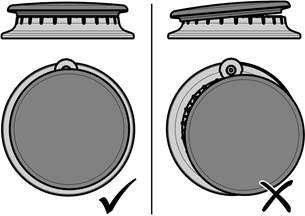


















Need help?
Do you have a question about the NGM5056UC and is the answer not in the manual?
Questions and answers